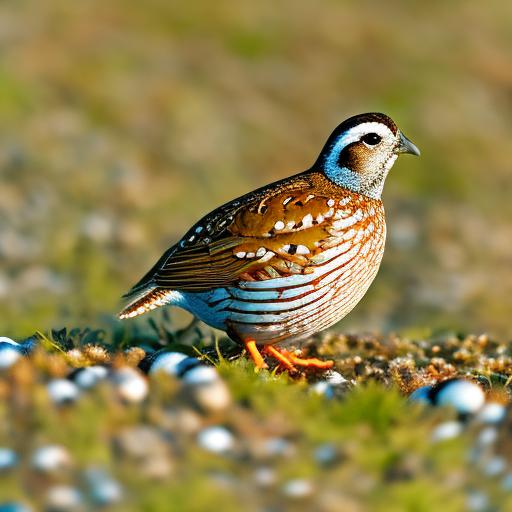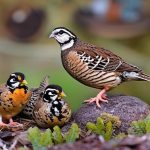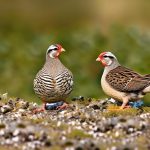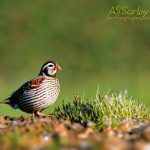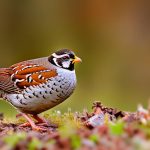Quail eggs, like all bird eggs, require a warm and stable environment for successful incubation. The warmth is essential for the development of the embryo inside the egg. The ideal temperature for quail eggs is around 99.5 to 100 degrees Fahrenheit, which is slightly lower than the temperature required for chicken eggs. Maintaining this temperature is crucial for the proper development of the embryo and the hatching of healthy quail chicks. If the eggs are not kept warm enough, the embryo may not develop properly, leading to failed hatching or the birth of weak and unhealthy chicks. On the other hand, if the eggs are exposed to temperatures that are too high, it can also lead to developmental issues and even death of the embryo. Therefore, it is important to understand the significance of keeping quail eggs warm and the impact it has on the successful hatching of quail chicks.
Quail eggs also require consistent warmth throughout the incubation period, which typically lasts for about 17 to 18 days. Any fluctuations in temperature can have a negative impact on the development of the embryos. It is important to provide a stable and warm environment for the eggs to ensure that they have the best chance of hatching successfully. Understanding the importance of maintaining a consistent temperature for quail eggs is crucial for anyone looking to hatch their own quail chicks. Without proper warmth, the eggs may not develop properly, leading to a lower hatch rate and potentially unhealthy chicks. Therefore, it is essential to prioritize keeping quail eggs warm throughout the entire incubation period to ensure successful hatching and the health of the newly hatched quail chicks.
Key Takeaways
- Keeping quail eggs warm is crucial for successful incubation and hatching
- A suitable nesting area with proper insulation and protection is essential for quail eggs
- Using an incubator provides a controlled environment for keeping quail eggs warm
- Maintaining the right temperature, humidity, and ventilation is key for quail egg incubation
- Regular monitoring and rotating of quail eggs ensures even heating and healthy development
Creating a Suitable Nesting Area for Quail Eggs
Creating a suitable nesting area for quail eggs is essential for ensuring their warmth and safety during the incubation period. The nesting area should be designed to mimic the natural nesting conditions of quails in the wild. This includes providing a warm and cozy environment that is free from drafts and disturbances. A common practice is to use a nesting box or tray filled with a soft and insulating material such as straw or wood shavings. This helps to provide a comfortable and warm space for the eggs to rest during incubation. It is important to ensure that the nesting area is well-ventilated to prevent the buildup of excess moisture, which can be detrimental to the development of the embryos inside the eggs.
In addition to providing a warm and cozy nesting area, it is also important to place the eggs in a position that allows for easy monitoring and rotation. This can be achieved by using an egg turner or by manually rotating the eggs several times a day. Proper rotation helps to ensure that the embryos develop evenly and prevents them from sticking to the inner membrane of the eggshell. Creating a suitable nesting area for quail eggs involves careful consideration of factors such as insulation, ventilation, and accessibility for monitoring and rotation. By providing a comfortable and secure nesting area, you can help to maximize the chances of successful hatching and the health of the newly hatched quail chicks.
Using an Incubator to Keep Quail Eggs Warm
Using an incubator is a popular and effective method for keeping quail eggs warm during the incubation period. Incubators are specifically designed to provide a controlled environment that mimics the natural conditions required for successful egg development. They are equipped with heating elements and temperature controls that allow for precise regulation of warmth. This makes them an ideal choice for anyone looking to hatch quail eggs, especially those who may not have access to natural brooding hens or suitable nesting areas. Incubators come in various sizes and designs, ranging from small tabletop models to larger cabinet-style units, making them suitable for different scales of quail egg incubation.
When using an incubator, it is important to carefully follow the manufacturer’s instructions for setting up and operating the equipment. This includes calibrating the temperature settings, ensuring proper ventilation, and regularly monitoring the temperature and humidity levels inside the incubator. It is also important to use a reliable thermometer and hygrometer to verify that the conditions inside the incubator are optimal for quail egg incubation. By using an incubator, you can create a controlled and stable environment that is essential for successful egg development. This method provides a convenient and reliable way to keep quail eggs warm throughout the entire incubation period, ultimately increasing the chances of a successful hatch and healthy quail chicks.
Maintaining the Right Temperature for Quail Eggs
Maintaining the right temperature is crucial for successful quail egg incubation. As mentioned earlier, the ideal temperature for quail eggs is around 99.5 to 100 degrees Fahrenheit. It is important to monitor and regulate this temperature consistently throughout the entire incubation period, which typically lasts for about 17 to 18 days. This can be achieved by using an incubator with precise temperature controls or by utilizing other methods such as natural brooding hens or carefully designed nesting areas. Regardless of the method used, it is essential to regularly check and adjust the temperature as needed to ensure that it remains within the optimal range.
In addition to maintaining the right temperature, it is also important to consider humidity levels during quail egg incubation. The ideal humidity level for quail eggs is around 50-60% relative humidity. This can be achieved by adding water to the incubator or nesting area as needed to maintain proper moisture levels. Proper humidity levels are essential for preventing excessive moisture loss from the eggs, which can lead to developmental issues or failed hatching. By maintaining the right temperature and humidity levels, you can create an environment that is conducive to successful quail egg incubation and ultimately increase the chances of hatching healthy quail chicks.
Monitoring and Rotating Quail Eggs for Even Heating
Monitoring and rotating quail eggs are important practices that help to ensure even heating and proper development of the embryos inside the eggs. It is essential to regularly monitor the temperature and humidity levels inside the incubator or nesting area to verify that they remain within the optimal range. This can be done using reliable thermometers and hygrometers, which should be checked frequently throughout the entire incubation period. Any fluctuations in temperature or humidity should be promptly addressed to prevent any negative impact on egg development.
In addition to monitoring, rotating quail eggs several times a day is also crucial for even heating and proper embryo development. This helps to prevent the embryos from sticking to the inner membrane of the eggshell and ensures that they receive consistent warmth from all sides. Rotating can be done manually by gently turning each egg or by using an automatic egg turner if available. Proper rotation helps to maximize the chances of successful hatching by promoting even development of the embryos inside the eggs. By consistently monitoring and rotating quail eggs, you can help to create an environment that is conducive to successful incubation and ultimately increase the chances of hatching healthy quail chicks.
Addressing Common Challenges in Keeping Quail Eggs Warm

Keeping quail eggs warm during incubation can present several challenges that need to be addressed in order to ensure successful hatching. One common challenge is maintaining consistent temperature and humidity levels, especially when using natural brooding hens or homemade nesting areas. Fluctuations in temperature or humidity can have a negative impact on egg development, so it is important to regularly monitor and adjust these conditions as needed. Another challenge is preventing excessive moisture loss from the eggs, which can lead to developmental issues or failed hatching. This can be addressed by maintaining proper humidity levels through regular addition of water to the incubator or nesting area.
Another common challenge is ensuring proper ventilation while keeping quail eggs warm. Poor ventilation can lead to a buildup of excess moisture, which can be detrimental to egg development. It is important to provide adequate ventilation while also maintaining a warm and cozy environment for the eggs. Additionally, addressing potential issues such as power outages or equipment malfunctions is crucial for ensuring that quail eggs remain warm throughout the entire incubation period. By being proactive in addressing these common challenges, you can help to create an environment that is conducive to successful hatching and the health of newly hatched quail chicks.
Ensuring the Health and Safety of Quail Eggs During Incubation
Ensuring the health and safety of quail eggs during incubation is essential for successful hatching and the development of healthy quail chicks. This involves providing a warm, stable, and clean environment that is free from potential hazards or disturbances. It is important to regularly inspect the eggs for any signs of damage or contamination, as these can negatively impact their development. Any damaged or contaminated eggs should be removed promptly to prevent any negative impact on neighboring eggs.
In addition to maintaining a clean environment, it is also important to handle quail eggs with care during collection and placement in the incubator or nesting area. Rough handling can lead to damage or hairline cracks in the eggshells, which can compromise their integrity and lead to failed hatching. Proper handling involves gently collecting and placing the eggs in a secure position where they can receive consistent warmth throughout incubation.
Furthermore, ensuring that quail eggs receive proper nutrition during incubation is also crucial for their health and development. This involves providing a diet that is rich in essential nutrients such as protein, vitamins, and minerals, which are necessary for healthy embryo development inside the eggs.
By prioritizing these measures, you can help ensure that quail eggs remain healthy and safe throughout incubation, ultimately increasing their chances of successful hatching and producing healthy quail chicks.
By prioritizing these measures, you can help ensure that quail eggs remain healthy and safe throughout incubation, ultimately increasing their chances of successful hatching and producing healthy quail chicks. This includes maintaining proper temperature and humidity levels in the incubator, regularly turning the eggs to prevent the embryo from sticking to the shell, and carefully monitoring for any signs of contamination or spoilage. Additionally, providing a clean and comfortable nesting environment for the adult quail can also contribute to the overall health and quality of the eggs. With these precautions in place, you can maximize the potential for successful hatching and the development of strong, thriving quail chicks.
If you’re looking for ways to keep your quail’s eggs warm, you may also be interested in learning about the importance of maintaining the right temperature in a chicken coop. Check out this informative article on choosing the right heater for a chicken coop to ensure that your poultry are kept comfortable and healthy.
FAQs
What is the ideal temperature for keeping a quail’s egg warm?
The ideal temperature for keeping a quail’s egg warm is around 99.5 to 100 degrees Fahrenheit (37.5 to 37.8 degrees Celsius).
How can I keep a quail’s egg warm without an incubator?
You can keep a quail’s egg warm without an incubator by using a heat lamp, a heating pad, or a homemade brooder made from a cardboard box and a light bulb.
How often should I turn a quail’s egg to keep it warm?
You should turn a quail’s egg at least three to five times a day to ensure even heating and prevent the embryo from sticking to the shell.
How long does it take for a quail’s egg to hatch?
It takes approximately 17 to 18 days for a quail’s egg to hatch once it has been kept at the ideal temperature and humidity.
What should I do if I find a quail’s egg outside of the nest?
If you find a quail’s egg outside of the nest, you can try to place it back in the nest if possible. If the egg has been out of the nest for an extended period, it may not be viable for hatching.
Meet Walter, the feathered-friend fanatic of Florida! Nestled in the sunshine state, Walter struts through life with his feathered companions, clucking his way to happiness. With a coop that’s fancier than a five-star hotel, he’s the Don Juan of the chicken world. When he’s not teaching his hens to do the cha-cha, you’ll find him in a heated debate with his prized rooster, Sir Clucks-a-Lot. Walter’s poultry passion is no yolk; he’s the sunny-side-up guy you never knew you needed in your flock of friends!

